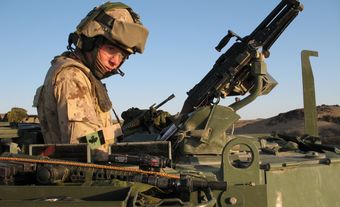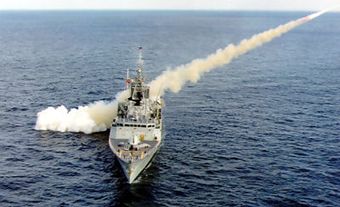The Princess Patricia’s Canadian Light Infantry (PPCLI, also known as the Patricia's) is one of three permanent Regular Force infantry regiments of the Canadian Army. Its current structure consists of three battalions and a reserve battalion, for a total of 2,000 soldiers lodged at bases in Edmonton, Alberta, and Shilo, Manitoba. The regiment has a proud history of service, dating back to its creation in the First World War.
Origins
When the Great War began in the summer of 1914, Captain Andrew Hamilton Gault undertook to finance and equip a regiment for overseas duty. On 10 August 1914, the regiment’s charter was signed, and within nine days its ranks were filled with veterans, many who had served in the South African War or other British imperial conflicts. The Governor General, Prince Arthur, Duke of Connaught, selected Lieutenant Colonel Francis D. Farquhar, DSO, of the Coldstream Guards as the Patricias’ first commander. The unit was named after the Governor General’s youngest daughter, Princess Patricia. The PPCLI arrived overseas for war service in October 1914.
First World War
For four years, the PPCLI fought through some of the toughest engagements of the war. It was the first Canadian battle unit to arrive in France and was soon thrown into the horrors of trench warfare. Farquhar himself died of wounds received in Belgium on 20 March 1915. The defence of Bellewaerde Ridge during the Second Battle of Ypres (April–May 1915) cost the regiment 400 casualties in one day.
The PPCLI eventually joined the 7th Canadian Brigade within the 3rd Canadian Division on 22 December 1915, and would serve as part of the Canadian Corps, which gained a reputation as the "shock troops" of the British army. During the Battle of Vimy Ridge (9–12 April 1917), the PPCLI served in the spearhead of the 3rd Division's assault on the ridge. It later endured the brutality of Passchendaele and the 100 Days campaign that led to the end of the war.
Three PPCLI soldiers — Sergeant George Mullin, Sergeant Robert Spall and Lieutenant Hugh McKenzie — were awarded the Victoria Cross for bravery during the Great War. (Spall and McKenzie were awarded theirs posthumously after being killed in action.)
After the war, the regiment participated in the failed Allied intervention in the Russian Civil War. After returning home in March 1919, the PPCLI was selected as a regiment for Canada’s permanent peacetime army. Companies were split up between bases in Winnipeg and Esquimalt, British Columbia. Peacetime service consisted of training, support of government action, and contributing to Canada’s officer training corps at universities in Central and Western Canada.
Second World War
The PPCLI was mobilized again for action in the Second World War. The regiment served as part of the 1st Canadian Infantry Division during Operation Husky, the invasion of Sicily, in July 1943. That was followed by the invasion of mainland Italy in September 1943. The Italian campaign was brutal: for 18 months, the Patricias fought hard battles at the Moro River, Villa Rogatti, the Gully, and helped to finally break the Hitler Line in May 1944, during the Allied push to Rome. The PPCLI became part of the newly created 1st Canadian Corps, participating in campaigns near the Adriatic coast, at the Gothic Line, San Fortunato, and Rimini.
In March 1945, the Patricias arrived in northwest Europe and were folded into the First Canadian Army. The regiment joined in the liberation of the Netherlands, capturing the city of Apeldoorn in April 1945. On 7 May 1945, the PPCLI was the first Allied force to enter Amsterdam, a day before Germany’s final surrender.
Cold War and NATO
The PPCLI was integrated into the postwar army and situated in Calgary. It was an important part of the new Mobile Striking Force (MSF), an innovative attempt to use the Canadian Army in a multi-purpose continental warfighting role, including parachute duty. In 1949, the PPCLI became Canada’s first peacetime parachute battalion. The regiment also rotated units into West Germany as part of Canada’s contribution to NATO forces in Europe, until the closing of Canadian Forces bases in Germany in 1994.
Korean War
During the Korean War (1950–53), the 2nd Battalion (2PPCLI) was dispatched as part of the Canadian Army Special Force under the command of the United Nations. The Chinese launched a major offensive to break through UN lines on 22 April 1951. The only major units between the Chinese and the South Korean capital of Seoul were the 2PPCLI, the 3rd Battalion Royal Australian Regiment, and a United States heavy tank regiment. A wave of Chinese soldiers pushed back the Australians and cut off the 2PPCLI. On the hills of Kapyong, members of the 2PPCLI fought off repeated Chinese attacks, earning their battalion the U.S. Distinguished Unit Citation for its “extraordinary heroism and outstanding performance of combat duties.”
Cyprus and the Balkans
The PPCLI served in numerous peacekeeping and humanitarian aid roles. In 1964 the UN Peacekeeping Force in Cyprus (UNFICYP) attempted to moderate the violence between Greek and Turkish factions and prevent conflict between the two NATO members. The regiment served there from 1968 until 1993.
After Yugoslavia crumbled into separate states and ethnic violence in 1991, the PPCLI served as part of the United Nations Protection Force (UNPROFOR). In September 1993, tasked with protecting Serbian civilians in Croatia, it fought Croatian forces in the Medak Pocket, the first combat operation for the Canadian Forces since Korea.
Afghanistan
In the wake of the terrorist attacks on the United States on 11 September 2001 (see 9/11 and Canada), the PPCLI was the first Canadian regiment to deploy to Afghanistan. It served alongside international forces in Operation Anaconda and Operation Harpoon, conducting combat operations against Taliban and al Qaeda strongholds. Four members of 3PPCLI were killed by "friendly fire" in the April 2002 Tarnak Farm incident, when Canadian soldiers conducting nighttime training were accidently targeted by a U.S. fighter pilot.
The PPCLI served with international forces in Afghanistan until 2014, conducting training, counter insurgency, and direct combat missions against Taliban insurgents.
Battle Honours
First World War: YPRES, 1915, ’17; Frezenberg; Bellewaarde; MOUNT SORREL; SOMME, 1916; Flers-Courcelette; Ancre Heights; ARRAS, 1917, ’18; Vimy, 1917; Arleux; HILL 70; Passchendaele; AMIENS; Scarpe, 1918; HINDENBURG LINE; Canal du Nord; PURSUIT TO MONS; FRANCE AND FLANDERS, 1914–18; SIBERIA, 1918–19
Second World War: LANDING IN SICILY; Leonforte; Agira; SICILY, 1943; The Moro; The Gully; LIRI VALLEY; Hitler Line; GOTHIC LINE; RIMINI LINE; San Fortunato; Savio Bridgehead; Naviglio Canal; Fosso Munio; Granarolo; ITALY, 1943–45; Apeldoorn; NORTHWEST EUROPE, 1945
Korean War: Kapyong; KOREA, 1951–53
Southwest Asia: AFGHANISTAN
Note: Battle honours in upper case indicate those awarded for participation in large operations and campaigns, while those in bold type are approved for emblazonment on regimental Colours.

Regimental Traditions and Insignia
Badge: A circle surmounted by a Crown with the words “PRINCESS PATRICIA’S CANADIAN LIGHT INFANTRY” around the circle and in the centre the coronet and cypher of Princess Patricia.
Unofficial Mottos: First in the Field; Once a Patricia, Always a Patricia
Regimental Celebrations: Princess Patricia’s Birthday (17 March)
Histories: David J. Bercuson, The Patricias: A Century of Service (2013)


 Share on Facebook
Share on Facebook Share on X
Share on X Share by Email
Share by Email Share on Google Classroom
Share on Google Classroom










